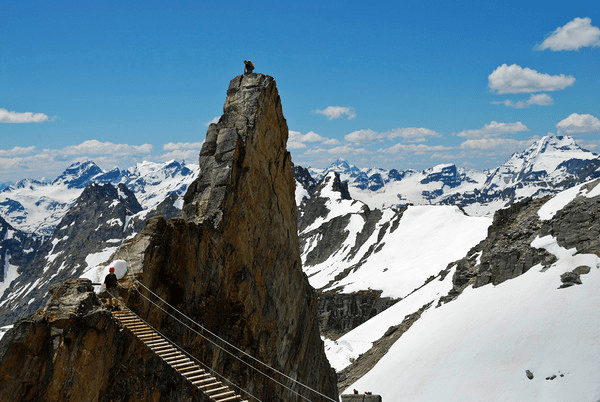Travel is always an adventure, be it tame or challenging. Sometimes just getting there is an adventure, but if you are like me, you like to spice up your vacation with adventure activities. These can range from a no-skills-required hot air balloon ride or a whale-watching trip, to activities that require more expertise like scuba diving or sailing. This is the first installment of a Friday series on adventure travel where I’ll be covering both tame and adrenaline pumping activities that will give you memories, photos and bragging rights long after you return home.

While people-watching on the beach with a cool libation in hand certainly has its merits, I tend to gravitate to more exhilarating adventures and have recently added a new spine-tingling adventure to my bucket list: to climb a via ferrata. Via ferrata is Italian for “iron way” and refers to a mountain trail with permanently fixed cables, rungs and bridges. Although they can look quite daunting, the installed hardware allows those of us who are not full-on mountain climbers safe access to otherwise inaccessible peaks without having to provide our own ropes and belays. In fact, even totally inexperienced climbers can traverse knife-edged ridges and ascend the sheer rock face of the easier via ferrata. A grading system for vie ferrate (plural) ranks them according to their difficulty to give would-be climbers a sense of exactly what skill level will be required. Physically, even children are capable of doing the beginner routes, but the dizzying heights and adrenaline factor require a bit of mental preparation for everyone.
The first vie ferrate were installed in the Italian Dolomites during World War I to help troops navigate at high altitude. Today, there are hundreds of vie ferrate throughout the mountain ranges of Europe where it is a popular adventure sport, but only a handful in North America and Asia and Latin America. Here are four that particularly intrigued me:
- Mt. Nimbus in the Purcell Mountains, British Columbia – North America’s longest and most extensive via ferrata route was constructed by CMH Summer Adventures. Professional CMH guides who have undergone lengthy and rigorous training lead small groups along a thrilling granite trail that traverses a 200-foot-long bridge over a 2,000-foot drop and on to the 8,000 foot summit. See breathtaking vistas from almost inconceivable vantage points all along the way on this full day adventure that ends with a 160-foot rappel.
- Torrent Falls in the Daniel Boone National Forest, Kentucky – This first via ferrata in the US traverses a huge horseshoe gorge. Along the route you can perch on a 120-foot-high ledge, cross a 70-foot-long bridge and walk behind a waterfall. The course has six different sections in four levels of difficulty with an exit point on each section. A day pass includes climbing, training and gear and a guide can be hired if desired.
- Mount Kinabalu in the Kinabalu National Park of Sabah, Malaysia – At 3,776 meters, this is the highest via ferrata in the world and the entire park is a UNESCO World heritage site. A pre-climb orientation and a climbing guide are mandatory for novices and experts alike. Mountain Torq manages several beginner and intermediate via ferrata routes and has led climbers from aged 10 to 70. A continuous belay system is employed so you cannot leave the course either intentionally or by accident.
- Sacred Valley of the Incas near Cusco, Peru – This intermediate route climbs 300 meters, crosses a bridge that is 250 meters high and ends in a 100 meter rappel back down. The course is privately managed by Natura Vive who provides round trip transportation from Cusco, a training session, all equipment, one guide for each group of five and a snack.
If you crave adventure and are ready for an adrenaline pumping rush, try a via ferrata climb. I’ll see you at the top!






Leave a Reply